胡壮麟语言学课件
- 格式:doc
- 大小:329.50 KB
- 文档页数:55



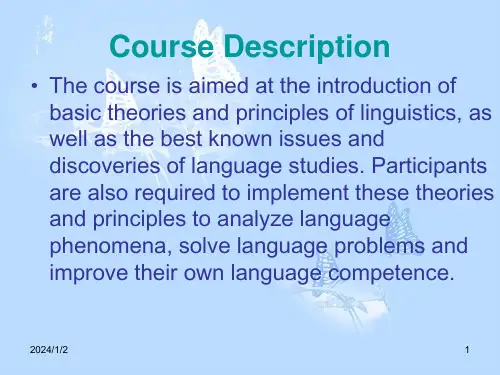
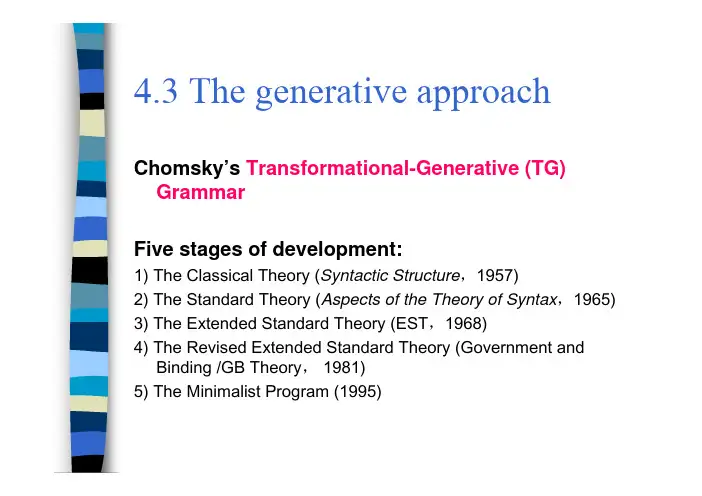
4.3 The generative approach Chomsky’s Transformational-Generative (TG) GrammarFive stages of development:1) The Classical Theory (Syntactic Structure ,1957)2) The Standard Theory (Aspects of the Theory of Syntax ,1965)3) The Extended Standard Theory (EST ,1968)4) The Revised Extended Standard Theory (Government and Binding /GB Theory ,1981)5) The Minimalist Program (1995)What is a generative grammar ?By a generative grammar ,Chomsky simply means “a system of rules that in some explicit and well-defined way assigns structural descriptions to sentences ”. He believes that every speaker of a language has mastered and internalized a generative grammar that expresses his knowledge of his language. “Thus a generative grammar attempts to specify what the speaker actually knows ,not what he may report about his knowledge.”(Chomsky ,1965) To generate is to predict what could be the possible sentences of language. Transformation is a kind of process that transforms one sentence into another. It uses a finite number of rules to produce infinite number of sentences.4.3.1 Deep and surface structures (Chomsky)Deep structure : the abstract representation of the syntactic properties of a construction.Surface structure : the final stage in the syntactic derivation of a construction. Transformational component hastransformational rules, which change the deep structure component into surface structures.Phrase structure rules (rewriting rules)Aux tense +(M) +(perf) + (prog) M model verbPerf have + -enProg be + -ingVP V +(NP) + (PP)PP prep + NPTense pres/pastThe mother of the boy and the girl will arrive soon4.3.3 Government, binding, etc. Lectures on Government and Binding (1981) Two systems of a grammar : a rule system, a principle systemSystem of principles :1) bounding theory2) government theory3) θ-theory4) binding theory5) case theory6) control theoryBinding TheoryA.An anaphor is bound in its governing category.B. A pronominal is free in its governing category.C. An r-expression is free.Anaphor is used in a narrow sense to includereflexives like myself and reciprocals like each other. Pronominal refer to pronouns other that reflexives and reciprocals.R-expressions (referential-expressions) cover all the other r-expressions except anaphors andpronominals, e.g. John, Bill, the man.Ex.(a)John 1likes himself 1.(b)They 1hit each other 1.(c)John 1doesn ’t like Bill ’s 2criticism of himself 1.(d)John 1 likes him 2.(e)Bill 1 says John 2likes him 2.(f)Bill 1says John 2likes the man 3.4.4 The functional approach4.4.1 Functional sentence perspective(FSP) Theme : “that which is known or at least obvious in the given situation and from which the speaker proceeds ”Rheme : “what the speaker states about, or in regard to, the starting point of the utterance ”(Danes 1974) Communicative dynamism(CD): “the extent to which the sentence element contributes to thedevelopment of the communication ”(J.Firbas 1964)4.4.2 Systemic-functional grammar Three general functions of language (Halliday):Ideational function (a. experiential b. logical)Interpersonal functionTextual functionThree grammatical systems (Halliday):TransitivityMoodthemeQuestions and Exercises What is the criterion used in IC analysis? In what ways is IC analysis better than traditional parsing?What are the problems in IC analysis? Discuss Chomsky ’s binding theory in relation to the Chinese reflexive 自己.In what sense is the analysis of a sentence in terms of theme and rheme functional?。
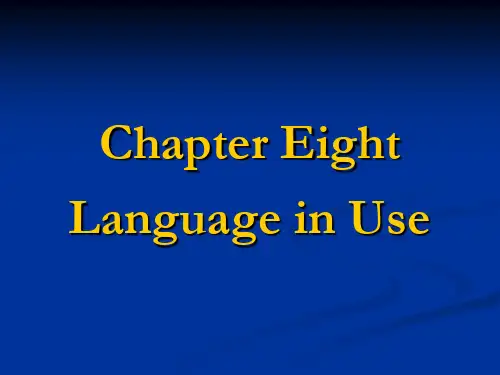
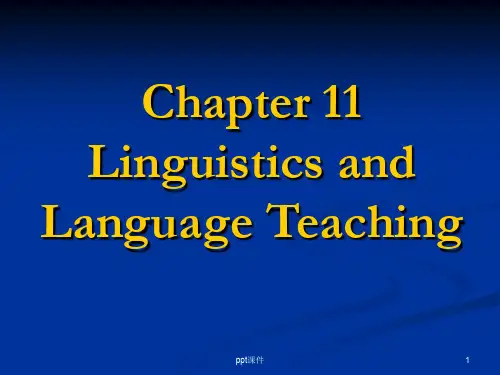
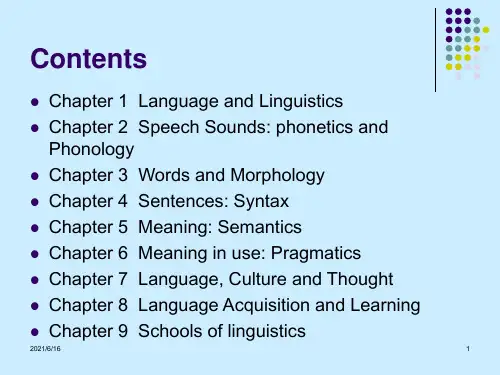
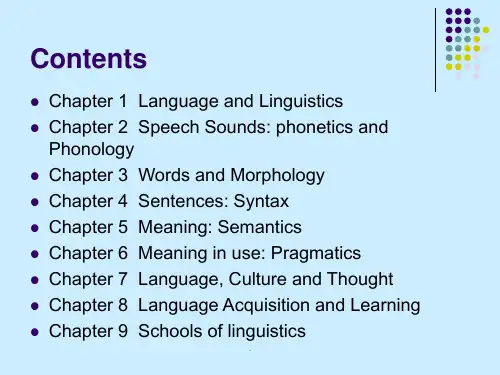


Chapter 12 Theories and SchoolsIntroduction 1 Modern linguistics began from theSwiss linguist Ferdinand deSaussure (1857-1913), who isoften described as “father of modernlinguistics”. His lectures arecollected in the book “Course inGeneral Linguistics”.2 Saussure believed that languageis a System of Signs. This sign isthe union of a form and an idea,which he called the signifier andthe signified.3 Saussure’s ideas on the arbitrarynature of sign, on the relationalnature of linguistic units, on thedistinction of Langue and Paroleand of Synchronic and Diachroniclinguistics pushed linguistics into abrand new stage.12.1The Prague School12.1.1 Introduction1) The Prague School can be traced back to its first meeting u nder theleadership of V.Mathesius in 1926. This school practiced a special style of synchronic linguistics, and its most important contribution to l inguistics is that it sees language in terms of function.2) Three most important ideas developed in Prague School12.1.2 Phonology & Phonological Oppositions1) The Prague School is best known for its contribution to p honology and thedistinction of phonetics and phonology.2) Its representative is Trubetzkoy.3) Oppositions ( a---I )bilateral opposition; multilateral opposition; proportio nal opposition; isolated opposition;privative opposition; gradual opposition; equivalent opposition;neutralisable opposition;constant opposition.12.1.3 Functional Sentence Perspective (FSP)1)Theme & Rheme.2) Communicative Dynamism (CD).Picture from the International Phonetic Congress, Amsterdam 1932 The person in the middle is the Dutch linguist Jac. van Ginneken; on his left is Nikolaj Trubetzkoy12.2 The London School12.2 The London School12.2.1 Malinowski’s theories12.2.2 Firth’s theories1)language is a means of doing things and of making others do thin gs.2) Prosodic Analysis.12.2.3 Halliday & Systemic-Functional Grammar1) Systemic Grammar2) Functional GrammarI) The ideational function is to convey new information, to communicate acontent that is unknown to the hearer.ii) The interpersonal function embodies all uses of language to express social and personal relations.iii) The textual function refers to the fact that language has mechanisms to make any stretch of spoken or written discourse into a coherent and unified text and make a living passage different from a random of senten ces.12.3 American Strcturalism 12.3.1 Early Period: Boas & Sapir12.3.2 Bloomfield’s theory1) Bloomfieldian Era2) BehaviourismStimulus-Response12.3.3 Post-Bloomfieldian Linguistics1) Harris & Methods in Structural Linguistics2) Hockett& A Course in Modern Linguistics3) K. Pike & Tagmemics12.4 Transformational-Generative Grammar1)Chomsky’s Syntactic Structure(1957) marked the beginning of the Chomskan Revolution.2) TG Grammar has seen five stages of development since its birth:the Classical Theory; the Standard Theory; the Extended T heory; the Revised Extended Standard Theory and the Minimalist Program.12.4.1 the Innateness Hypothesislanguage is innate, and children are born with a Language Ac quisition Device ( LAD).12.4.2 What is a Generative Grammar?1) By a Generative Grammar,Chomsky simply means “a system of rules that in some explicit and well-defined way assigns structural descriptions to sentences.2)Chomsky put forward three different levels to evaluate grammar on:Observational Adequacy; Descriptive Adequacy and the Exp lanatory adequacy.12.4.3 The Classical Theory12.4.4 The Standard Theory12.4.5 The Extended-Standard Theory12.4.6 Later Theories12.5 Revisionists? Rebels?12.5.1 Case GrammarCase Grammar is an approach that stresses the relationship o f elements in a sentence. It is a type of generative grammar developed by C.J. F illmore in the late 1960s.in this grammar, the verb is the most important part of the sentence, and has a number of case-making relationships with various noun phrases.12.5.2 Generative Semantics.Generative Semantics, developed in the late1960s and early 1970s, is a reaction to Chomsky’s Syntactic-based TG Grammar.The leading figures are J.R. Ross, G. Lakoff, J.D. Cawley, and P.Postal. Generative Semantics considers that all sentences are generate d from a semantic structure.Generative Semantics holds that there is no principled distinct ion between syntactic processes and semantic processes.Questions for Discussion1 Why is Saussure hailed as the father of modern linguistics?2 What are the three important points of the Prague School?3 What is the essence of Functional Sentence Perspective?4 What is special about systemic –Functional linguistics?5 What are the special features of American structuralism?6 How is behaviorist Psychology related to linguistics?7 How many stages of development has Chomsky’s TGGrammar undergone?8 What is special about TG Grammar?9 What is Case Grammar?。
Chapter 5 Meaning Semantics:the study of the meaning of linguistic units, words and sentences in particular.5.1 Meanings of “meaning”7 types of meaning(Leech):1. Conceptual meaning: Logical, cognitive, ordenotative contentAssociate meaning:2. Connotative meaning:What is communicatedby virtue of what language refers to.3. Social meaning:What is communicated of thesocial circumstances of language use.4. Affective meaning: What is communicated ofthe feelings and attitudes of thespeaker/writer.5. Reflected meaning: What is communicatedthrough association with another sense ofthe same expression.6. Collocative meaning: What is communicatedthrough association with words which tendto occur in the environment of another word.7.Thematic meaning: What is communicatedby the way in which the message isorganized in terms of order and emphasis.-Connotation and denotation5.2 The referential theory-The theory of meaning which relates the meaning of a word to the thing it refers to, or stands for, is known as the referential theory.-Semantic triangle(Ogden and Richards):conceptword thing-Sense and reference5.3 Sense relationsSense: the semantic relations between one word and another, or more generallybetween one linguistic unit and another.3 kinds of sense relations:1)Sameness relation---Synonymy2)Oppositeness relation---Antonymy3)Inclusiveness relation---Hyponymy5.3.1 Synonymy1)Differ in style: buy and purchase2) Differ in connotations: thrifty, economicaland stingy3) Dialectual difference: autumn and fall, flatand apartment, underground and tube5.3.2 Antonymy1) Gradable antonymy: good-bad, long-short, big-small, hot-cold, warm-cool“Marked”(unusual)and “Unmarked”(the cover term, unusual, e.g. old)2) Complementary antonymy:alive-dead, male-female,present-absent, pass-fail (a test),odd-even, hit-miss (a target), boy-girl3) Converse antonymy(Relational opposite): buy-sell, lend-borrow, give-receive, before-after, husband-wife, host-guest, employee-employer5.3.3 Hyponymy Hyponyms: the members, the lower termsCo-hyponyms: members of the same classSuperordinate:the name of a classA superordinate may be missing. Hyponyms may also be missing.Ex. livingplant animalbird fish insect animalhuman animaltiger lion elephant …5.4 Componential analysis Componential analysis refers to an approach by structural semantics in describing the meaning of words.It aims at breaking down the meaning of a word into its minimal distinctive features which are also called components.E.g. the meaning of the word boy may be analyzed into three components: HUMAN, YOUNG and MALE. Girl may be analyzed into HUMAN, YOUNG and FEMALE; man into HUMAN, ADULT and MALE, and woman into HUMAN, ADULT and FEMALE.5.5 Sentence meaning5.5.1 An integrated theoryThe principle of compositionality: the meaning of a sentence depends on the meanings of the constituent words and the way they are combined.A semantic theory consists of two parts(Katz and Postal): a grammantical classification and semantic rules.Grammatical/Syntactic markers Semantic markers DistinguishersSelection restrictions Problems5.5.2 Logical semantics Propositional logic( propositional calculus or sentential calculus) is the study of the truth conditions for propositions: how the truth of a composite proposition is determined by the truth value of its constituent propositions and the connections between them.“A proposition is what is expressed by a declarative sentence when that sentence is uttered to make a statement.”(J.Lyons)Predicate logic( predicate calculus) studies the internal structure of simple propositions.Argument and predicateAn argument is a term which refers to some entity about which a statement is being made.A predicate is a term which ascribes some property, or relation, to the entity, or entities, referred to. In terms of the number of arguments it takes, it can be classified into: one-place predicate: Socrates is a man.two-place predicate:John loves Mary.three-place predicate: John gave Mary a book.Questions and Exercises Some people maintain that there are no truesynonyms. If two words mean really the same, one of them will definitely die out. Do you agree? In general what type of meaning we are talking about when we say two words are synonymous with each other?Consider the following antonyms: friendly:unfriendly, honest: dishonest, normal: abnormal, logical: illogical.Which type of antonymy do they belong to?Comment on F.R.Palmer’s following argument: “…We can treat male/female, married/single, alive/dead as gradable antonyms on occasions. Someone can be very male or more married and certainly more dead than alive.”Which type of antonymy do the following antonyms belong to? Bigger:smaller, longer:shorter, better: worse, older: younger.姜望琪(1991:79)claims that “To some extent, we can say that any two words of the same part of speech may become antonyms, as long as the meaning difference between them is what needs to be emphasized in the particular context.”He uses the two sentences below as examples. What do you think of the claim?You have to peel a raw potato but you can skin a boiled one. He’s no statesman, but a mere politician.。
1.3 Design features of languageDesign features:the features that define our human languages. They make our language advantageous over animal “languages”.1.3.1 ArbitrarinessThe forms of linguistic signs bear nonatural relationship to their meaning.(Saussure)(1) Arbitrary relationship between the soundof a morpheme and its meaning(2) At the syntactic level(3) Arbitrariness and convention1.3.2 Duality“By duality is meant the property of having two levels of structures, such that units of theprimary level are composed of elements ofthe secondary level and each of the twolevels has its own principles of organization”(Lyon, 1982:20).Advantage:A large number of different units can be formed our of a small number ofelements.1.3.3 CreativityLanguage can produce sentence that has never been heard. Language is resourceful because of its duality and recursiveness.1.3.4 DisplacementHuman languages enable their users to symbolize objects, events and concepts which are not present ( in time and space) at the moment of communication.Other design featuresCultural transmissionLanguage is passed down from generation to generation. Human being must be exposed to language environment.InterchangeabilityAny human being can be both a producer and receiver of the message.1.4 Origin of languageThe bow-wow theoryThe pooh-pooh theoryThe “yo-he-ho”theory1.5 Functions of language 1.5.1 Informative1.5.2 Interpersonal function1.5.3 Performative1.5.4 Emotive function1.5.5 Phatic communion1.5.6 Recreational function1.5.7 Metalingual function1.6 What is linguistics?Linguistics is the scientific study of language.1.7 Main branches of linguistics1.7.1 PhoneticsPhonetics is the subfield of linguistics thatstudies speech sounds in human language. Major domains: Articulatoryphonetics1.7.2 Phonology-Phonology is the subfield of linguistics that studies the sound pattern of a language. -It deals with the rules governing the structure, distribution and sequencing of speechsounds and the shape of syllables.-Phonetics vs. PhonologyPhonetics is the study of speech soundsthat the human voice is capable of creating whereas phonology is the study of a subset of those sounds that constitute languageand meaning. The first focus on chaos while the second focuses on order.1.7.3 MorphologyMorphology is the subfield of linguistics that studies the internal structure of words andthe relationships among words.1.7.4 SyntaxSyntax is the subfield of linguistics thatstudies the internal structure of sentencesand the relationships among the internalparts.1.7.5 SemanticsSemantics is the subfield of linguistics that studies the nature of the meaning ofindividual words, and the meaning of words grouped into phrases and sentences.1.7.6 PragmaticsPragmatics is the subfield of linguistics that studies the use of words, phrases andsentences in the actual context of discourse.1.8 Macrolinguistics1.8.1 PsycholinguisticsPsycholinguistics studies the relationshipbetween language and mind. It also studies language development in the child, biological foundations of language and the relationship between language and cognition.1.8.2 SociolinguisticsSociolinguistics is the study ofcharacteristics of language varieties, thecharacteristics of their functions, and thecharacteristics of their speakers.1.8.3 Anthropological linguisticsAnthropological linguistics is the study of the history and structure of formerly unwrittenlanguages. They are concerned with theemergence and divergence of languagesover thousands of years.1.8.4 Computational linguisticsComputational linguistics is aninterdisciplinary field which centers aroundthe use of computers to process or produce human language.1.9 Important distinctions in linguistics1.9.1 Descriptive vs. prescriptive-Descriptive(non-normative): to describe what people say. “…the linguist tries to discoverand record the rules to which the members ofa language-community actually conform anddoes not seek to impose upon them otherrules, or norms, of correctness.”(Lyon,1982:47)-Prescriptive: to prescribe how people shouldsay. In the 18th century, the grammarianstried to lay down rules for the correct use oflanguage and settle the disputes over usage once and for all.1.9.2 Synchronic vs. diachronic-Synchronic linguistics is the study of a given language at a given period of time. E.g. “A Grammar of Modern Greek”-Diachronic linguistics is the study of the changes the language has experienced.1.9.3 Langue & parole(Saussure)-Langue is the abstract linguistic form or system shared by all the members of a speech community. It is a social product. It is a set of convention.-Parole is the actual or actualized language. It is the concrete use of the conventions or application of the rules.1.9.4 Competence and performance (Chomsky)-Competence refers to the ideal language speaker’s underlying knowledge about the system of rules.-Performance refers to the actual use of language by the speaker in concrete situation.1.9.5 Etic vs. Emic(Pike)Questions and ExercisesDo you think that onomatopoeia indicates a non-arbitrary relationship between form and meaning? Does the traffic light system have duality, why?Communication can take many forms, such as sign, speech, body language and facial expression.Do body language and facial expression share or lack the distinctive properties of human language? Can you mention some typical expressions of phatic communion in Chinese?。
胡壮麟语言学课件Chapter OneInvitations to Linguistics1.1 Why Study LanguageLanguageFeaturesFunctionLanguage learningfirst language leaningsecond language learning1.2 What Is LanguageLanguage is a system of arbitrary vocal symbols used for human communication.System: elements in language are arranged according to certain rules.Arbitrary: There is no intrinsic connection between the word and its meaning.Symbolic nature of language: words are associated with objects, actions, ideas by convention.1.3 Design Features of LanguageDesign features are features that define our human language.Design Features of Language(1)Arbitrariness: the fact that the forms of linguistic signs bear no natural relationship to their meaning.arbitrariness at different levels of a language1) arbitrary relationship between the sound of a morpheme and its meaning2) arbitrariness at the syntactic levelapples, pears and bananaspears, apples and bananasb) He came in and sat down.He sat down and came in.He sat down after he came in.c) She got married and had a baby.She had a baby and got married.d) 屡战屡败屡败屡战3) arbitrariness and conventionarbitrariness→ language creativeconvention→ learnabili ty;→ learning a language laborious1.3 Design Features of Language(2)Duality: the property of having two levels of structures1) sound— secondary units2) meaning — primary units1.3 Design Features of Language(3)Creativity(productivity): Users can understand and produce sentences they have never heard before.1) Words can be used in new ways to mean new things.mouse bridge2) Its potential to create endless sentences by recursiveness (递归性)e.g. a. Smith believes that the earth is flatb. Brown believes that Smith believes that the earth is flatc. Smith believes that Brown believes that Smith believes that the earth is flatd. Brown believes Smith believes that Brown believes thatSmith believes that the earth is flat山里有座庙,庙里有个和尚,老和尚在念经,念的什么经:山里有座庙,庙里有个和尚,老和尚在念经,念的什么经:山里有座庙,庙里有个和尚,老和尚在念经,念的什么经……1.3 Design Features of Language(4)Displacement means that human languages enable their users to symbolize objects, events and concepts which are not present (in time or space) at the moment of communication.1.3 Design Features of Language(5)Cultural transmission: language is passed on through teaching and learning, rather than by instinct.1.4 Origin of LanguageThe bow-wow theory汪汪理论: imitate the sounds of the animals. onomatopoeicThe pooh-pooh theory噗噗理论: instinctive sounds of pain, anger and joy. interjectionThe yo-he-ho theory哟嗬哟理论: rhythmic grunts produced when working . chantsOrigin of LanguageThe divine-origin theory“So he (God) took some soil from the ground and formed all the animals and all the birds. Then he brought them to the man to see what he would name them, and that is how they got their names. So the man named all the birds and the animals,…”(Genesis,Chapter11:6)The invention theorya. imitativeb. cries of naturec. grunts of men working togetherThe evolution theory1.5 Functions of Language(1)Jakobson"Linguistics and Poetics: Closing Statement"All acts of communication, be they written or oral, are contingent on six constituent elements: context, message, addresser, addressee, contact and codeEach of the constituent elements of the communicative act has a corresponding function; thus:referential,poetic,emotive,phatic, conative and metalingualcontextREFERENTIALAddresser message addresseeEMOTIVE POETIC CONA TIVEcontactPHA TICcodeMETALINGUALReferential : to convey message and informationEmotive: to express attitudes, feelings and emotionsPoetic: to indulge in language for its own sakeConative: to persuade and influence others through commands and requestsPhatic: to establish communion with othersMetalingual: to clear up intentions and meanings1.5 Functions of Language(2)Halliday: three metafunctions of language:1) ide ational function is to organize the speaker’s or the writer’s experience of the real or imaginary world, i. e. language refers to real or imagined persons,things actions,events,states,etc.达意功能指组织说话者或作者现实或虚构世界的体验,即语言指称实际或虚构的人、物、动作、事件、状态等。
Chapter OneInvitations to Linguistics1.1 Why Study Language⏹Language⏹Features⏹Function⏹Language learning⏹first language leaning⏹second language learning1.2 What Is Language⏹Language is a system of arbitrary vocal symbols used for human communication.⏹System: elements in language are arranged according to certain rules.⏹Arbitrary: There is no intrinsic connection between the word and its meaning.⏹Symbolic nature of language: words are associated with objects, actions, ideas by convention.1.3 Design Features of Language⏹Design features are features that define our human language.⏹Design Features of Language(1)⏹Arbitrariness: the fact that the forms of linguistic signs bear no natural relationship to their meaning.⏹arbitrariness at different levels of a language⏹1) arbitrary relationship between the sound of a morpheme and its meaning⏹2) arbitrariness at the syntactic levelapples, pears and bananas⏹pears, apples and bananasb) He came in and sat down.⏹He sat down and came in.⏹He sat down after he came in.⏹c) She got married and had a baby.⏹She had a baby and got married.⏹d) 屡战屡败⏹屡败屡战⏹3) arbitrariness and convention⏹arbitrariness⏹→ language creative⏹convention⏹→ learnabili ty;⏹→ learning a language laborious1.3 Design Features of Language(2)⏹Duality: the property of having two levels of structures⏹1) sound— secondary units⏹2) meaning — primary units1.3 Design Features of Language(3)⏹Creativity(productivity): Users can understand and produce sentences they have never heard before.⏹1) Words can be used in new ways to mean new things.⏹mouse bridge⏹2) Its potential to create endless sentences by recursiveness (递归性)⏹e.g. a. Smith believes that the earth is flat⏹ b. Brown believes that Smith believes that the earth is flat⏹ c. Smith believes that Brown believes that Smith believes that the earth is flat⏹ d. Brown believes Smith believes that Brown believes that Smith believes that the earth is flat⏹山里有座庙,庙里有个和尚,老和尚在念经,念的什么经:山里有座庙,庙里有个和尚,老和尚在念经,念的什么经:山里有座庙,庙里有个和尚,老和尚在念经,念的什么经……1.3 Design Features of Language(4)⏹Displacement means that human languages enable their users to symbolize objects, events and concepts which arenot present (in time or space) at the moment of communication.1.3 Design Features of Language(5)⏹Cultural transmission: language is passed on through teaching and learning, rather than by instinct.1.4 Origin of Language⏹The bow-wow theory汪汪理论: imitate the sounds of the animals. onomatopoeic⏹The pooh-pooh theory噗噗理论: instinctive sounds of pain, anger and joy. interjection⏹The yo-he-ho theory哟嗬哟理论: rhythmic grunts produced when working . chantsOrigin of Language⏹The divine-origin theory⏹“So he (God) took some soil from the ground and formed all the animals and all the birds. Then he brought them to the man to see what he would name them, and that is how they got their names. So the man named all the birds and the animals,…”(Genesis,Chapter11:6)⏹The invention theory⏹ a. imitative b. cries of nature⏹ c. grunts of men working together⏹The evolution theory1.5 Functions of Language(1)⏹Jakobson⏹"Linguistics and Poetics: Closing Statement"⏹All acts of communication, be they written or oral, are contingent on six constituent elements: context, message, addresser, addressee, contact and code⏹Each of the constituent elements of the communicative act has a corresponding function; thus:⏹referential,poetic,emotive,phatic, conative and metalingual⏹context⏹REFERENTIAL⏹Addresser message addressee⏹EMOTIVE POETIC CONA TIVE⏹contact⏹PHA TIC⏹code⏹METALINGUAL⏹Referential : to convey message and information⏹Emotive: to express attitudes, feelings and emotions⏹Poetic: to indulge in language for its own sake⏹Conative: to persuade and influence others through commands and requests⏹Phatic: to establish communion with others⏹Metalingual: to clear up intentions and meanings1.5 Functions of Language(2)⏹Halliday: three metafunctions of language:⏹1) ide ational function is to organize the speaker’s or the writer’s experience of the real or imaginary world, i. e. language refers to real or imagined persons,things actions,events,states,etc.达意功能指组织说话者或作者现实或虚构世界的体验,即语言指称实际或虚构的人、物、动作、事件、状态等。
⏹2) Interpersonal function is to indicate, establish, or maintain social relationships between people.It includes forms of address, speech function, MODALITY, etc.人际功能表明、建立或维持人与人之间的社会关系,包括称谓形式,语言功能,情态等。
⏹3) Textual function is to create written or spoken TEXTs which cohere within themselves and which fit the particular situation in which they are used.⏹组篇功能指组成书面或口头的语篇,这些语篇内部连贯,并适用于所用的特定场景。